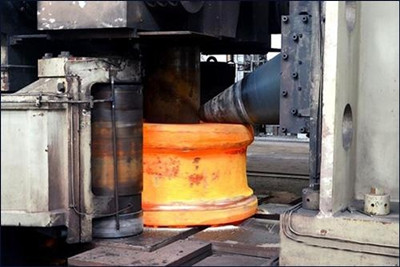Like isothermal forging, hot die forging is a promising precision forging process. The difference is that the die temperature of hot die forging is higher than that of common forging, but lower than that of isothermal forging. Typical hot die forging die temperature is 110 – 225 C lower than blank temperature. Compared with isothermal forging, die materials can be widely used because of the decrease of die temperature, but the ability of forming very thin and complex shape forgings is slightly poor.

Compared with conventional forging, hot die forging has the following advantages:
(1) Reducing the material consumption of forgings during hot die forging reduces the quenching of the die contacting blank and the work hardening of the material, and improves the Forgability of the material. Therefore, the forgings are allowed to have smaller fillet radius, smaller die drawing inclination and smaller forging allowance, thus greatly reducing the quality of the forgings. For example, the quality of a Ti-6Al-4V alloy structural part is 28 kg. The quality of the forgings produced by conventional forging process is 154 kg. The quality of the forgings produced by hot die forging process is 109 kg. The difference between the two methods is 45 kg.
(2) Reduce the number of forging operations and improve the working ability of the press. When hot die forging, the die temperature is higher and the blank temperature drops less. Conventional forging requires two, three or more fires to form the forgings. Hot die forging only takes one time and can be completed at most two fires. Because of hot die forging, the metal deformation resistance is low, which increases the working capacity of the equipment relatively.
(3) Reduce the amount of forgings machined, because the forgings produced are close to the weight and contour size of the parts, so compared with the forgings produced by conventional forging, the amount of material removal in mechanical processing is reduced.
(4) The homogeneity of the product is better because the temperature gradient decreases greatly in the forging process and the uneven deformation caused by the temperature gradient is easy to alleviate. Therefore, the homogeneity and consistency of the structure and properties of the product are better than those of the forgings produced by conventional forging, but not as good as those produced by isothermal forging.
In hot die forging, although the blank has a temperature drop, it is still in the forging temperature range, and the deformation resistance does not rise as sharply as in conventional forging. The strain rate used in hot die forging varies from 0.05 to 0.2s-1. If the strain rate is too low, the billet temperature may decrease.
In hot die forging of titanium alloy, the heating temperature, strain rate, microstructure and holding time of preformed billet are very important factors, which play a decisive role in the dimensional accuracy and microstructures of formed parts. Generally, lower strain rate and longer holding time increase the possibility of precision forming. The microstructures of preform have direct effects on flow stress and superplasticity, especially on the structure after forging. It is not possible to eliminate the defects and grain inhomogeneity in raw materials completely by isothermal forging or hot die forging.
At present, whether titanium alloy and superalloy are forged by hot die mainly depends on the total cost of forgings or the need of uniformity and consistency of products. The development trend of this technology is to use conventional forging to preform billets and finally to finish isothermal or hot die forging.
